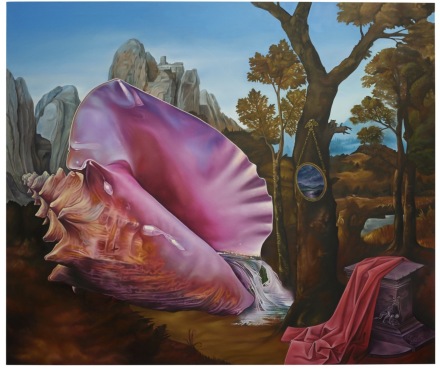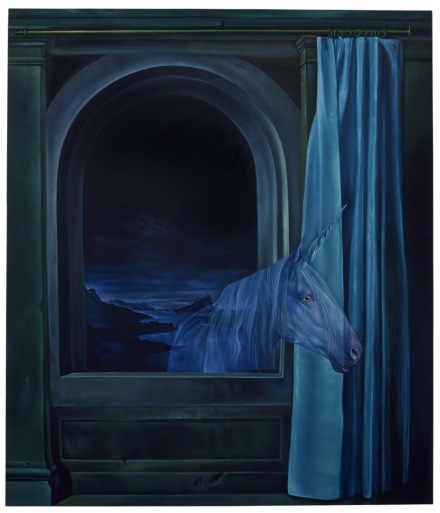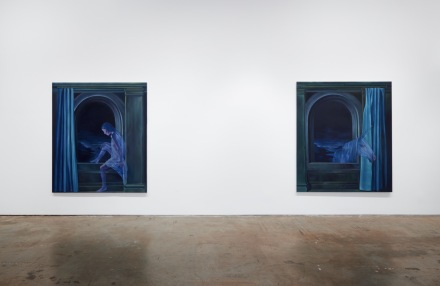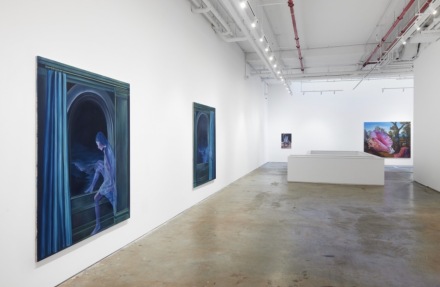
Ariana Papademetropoulos, Phases of Venus (2022), via Vito Schnabel Gallery
This month, Vito Schnabel Gallery presents Ariana Papademetropoulos: Baby Alone in Babylone, an exhibition of new paintings that find the Los Angeles-based artist drawing upon 15th century lore of the mythical unicorn. In her exploration of this theme, Papademetropoulos considers iconography from two celebrated tapestry series of the late Middle Ages: The Lady and the Unicorn (Musée National du Moyen Âge, Paris), an allegorical fable of the five senses, and The Hunt of the Unicorn (The Cloisters, Metropolitan Museum of Art, New York), a narrative unfolding of the swift, wild horned creature who could only be tamed by a virgin maiden. Constructing her own enigmatical tale in the present day, Papademetropoulos invites viewers to journey between collapsing realities and converging realms, through a sequence of hyperreal, dream-like episodes that coalesce in a story of awakening and transformation.

Ariana Papademetropoulos, View from Tower II (2022), via Vito Schnabel Gallery
The unicorn has long occupied collective consciousness. A familiar presence in visual art, music, and literature of the Middle Ages, the unicorn is always depicted in a flourishing natural world of flora and fauna that would suggest its existence is as real as our own. The creature’s symbolism is tied to both religious and secular allegory, as it represents fertility and marriage, purity and rebirth. As Europe emerged from the Dark Ages and the Renaissance began to blossom, human sensuality was awakening in new forms; thus the unicorn came to represented Christendom as an allegory of Christ while simultaneously holding secular significance as symbol of courtly love, marriage, and revelry manifested in pure physical form.

Ariana Papademetropoulos, Baby Alone in Babylone (Installation View), via Vito Schnabel Gallery
In Baby Alone in Babylone, Papademetropoulos’ narrative begins with Self Portrait 1996, an intimately-scaled canvas depicting the young unicorn in a dark domestic interior, curled up in a wooden lyre-back chair. Small white flowers sprout from the cane roped seat, while a teardrop falls from the corner of the foal’s eye. The artist’s usual dazzling technicolor palette is here restrained, replaced by somber hues and silver iridescence that endow the image with mystery and a suggestion of claustrophobia. As her unicorn grows into adulthood, it remains barricaded in a wood paneled chamber. The heavy, looming architecture of Horror Vacui has been shaped by the masculine energy of the medieval hunt, with its impetus to seize, capture and constrain. Isolated and locked away, the subdued unicorn, is rendered in a translucent veil of cool violet and aquamarine, stares longingly into a mirror where a woman’s face gazes back.

Ariana Papademetropoulos, Baby Alone in Babylone (Installation View), via Vito Schnabel Gallery
Throughout the show, art historical references mingle with imagery related to alchemy and the archetypes of Jungian psychology, all in the service of the artist’s unicorn story– a new legend that hints at self-portraiture while broaching topics of femininity and womanhood in general, inviting viewers to reflect upon these highly charged themes in a contemporary context.
The show closes January 7th.
– D. Creahan
Read more:
Ariana Papademetropoulos at Vito Schnabel [Exhibition Site]



